It was an historic first. An event to remember. Inscribe Sunday, September 6th, 1964 on your perpetual calendar, one of those auspicious dates to celebrate and to emulate if you can. It was the day Art Van Elslander eclipsed the Beatles!
Consider for a moment those four charismatic lads from Liverpool. On their first tour of the U.S, backed by high power promotion, with 5,000,000 posters distributed nation-wide plus every other media proven effective at that time, the Beatles packed Detroit’s legendary Olympic Stadium’s 15,000 capacity at both afternoon and evening shows. They’d come prepared to conquer. At least they tried.
But simultaneously, “Mr. Van”, star entrepreneur, ran dynamite round-the-clock radio commercials, inviting one and all to visit not the Beatles, but his magnificent pavilion furniture liquidation sale, staged at the Michigan State Fairgrounds that very same day.
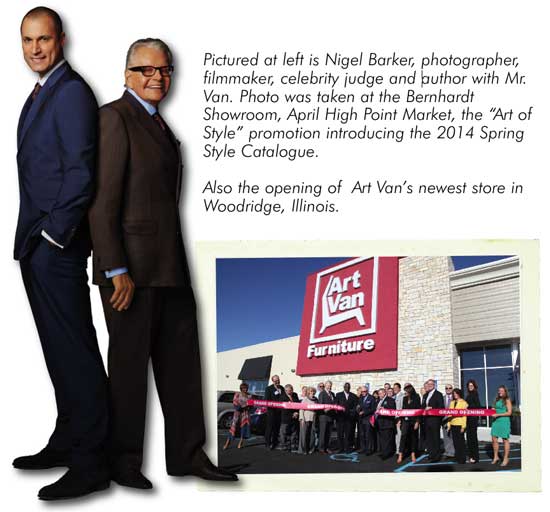
He had reached a jumping off point. An economic downturn had precipitated a decline in sales. With seven stores, Art had taken on three partners, his brother Bob, Dan Fox and Bob McEachin and, to quote the company bio printed to mark the 50th anniversary (1959-2009), “He knew as sure as sofas have cushions that he couldn’t run the company ‘business as usual’. The company was facing the possibility of bankruptcy.”
He knew it was time “to get creative”. Then and now, Art loved a challenge. He packed the 27,000 square foot space wall-to-wall with inventory. He knew he had serious competition and he “was worried we wouldn’t have anyone at the sale because of the concert”. But customers swarmed the pavilion in their thousands. Art and his team converted everything to cash. “Many of my peers in the industry came out to help with the sale, even those who worked for other companies. That was amazing.” And he added, “It was extremely humbling. We were on our knees. Before that sale, we couldn’t pay our bills.” And, “It taught me an important lesson, do not expand beyond your financial ability.”
Retiree Clint Loren, who was Art’s second employee back in 1961, worked at the sale “nearly around the clock. Times were tough. We had a lot of merchandise and no money.”
And Al Hassan, Art’s very first employee, said, “That sale was one of Art’s most glorious moments. It was one of the greatest comebacks we had. That sale helped put us back on the map.”
Now, circa 2014, a half-century later, Art Van Furniture is the top family owned furniture retailer in the Midwest and the fifteenth largest in the United States. Art Van Elslander, founder, now champions the role of Chairman. His sons work with him, Gary Van as President, and David Van, Vice President of PureSleep and Clearance Centers. The company currently employs close to 4000 people in its “family of associates”. There are 37 stores in Michigan and seven more outside the state in Ohio, Illinois and Indiana. It also operates 40 Art Van PureSleep free-standing bedding stores in Michigan, Ohio and Indiana.
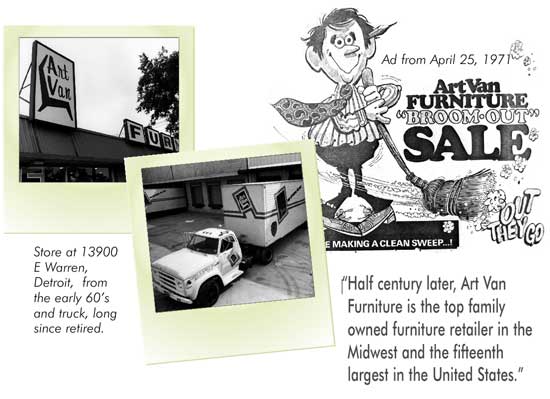
“We’ve found sleep stores are the fastest growing specialty channels. Research tells us that bedding is purchased as a matter of convenience after a bad night’s sleep or a bad back. People want to buy a new mattress right now! So we have added the free-standing stores as a matter of convenience.” And with all the bells and whistles of advanced technology.
Paul’s TV, “The King of Big Screen”, found a home within Art Van stores. And in spring this year, the company acquired World of Floors, the largest specialty flooring chain in Michigan with 27 stores. Said World of Floors former CEO, Emil Pedick, “I envisioned a store within a store concept that leveraged the marketing and customer base” of the operation.
Born in Detroit to Achiel Elslander and his wife, Rosa, endowed with their sturdy, disciplined Belgian traditions, Art was inspired and motivated from his earliest days by his father’s stability and strong work ethic. Art talks about his Dad’s lack of formal education, that his independent spirit propelled him from hard labour into the proud ownership of a Detroit bar. “He worked very hard but he always said, ‘It’s mine, and I can be in charge of my own future.’”
Undoubtedly he was inspired as well by his environment, by the City itself. A major great lake port connecting the Great Lakes System with the St. Lawrence Seaway, Detroit was and is one of North America’s most fascinating, volatile and energetic centers of transportation, business, finance and culture. Sports legends rank high with the legendary Tigers and Red Wings, international sailboat racing and, once upon a time, the great boxer Joe Louis. The music of MoTown was and is enjoyed worldwide. Then there are the astonishing treasures of the Detroit Institute for the Arts, the enchanting Cranbrook Art Museum and the extraordinary Greenfield Village, where the origins of the automotive industry come alive. The City’s history is lengthy and dramatic with potent memories of the Seven Years War and the War of 1812. In the 1920s, with Prohibition, Detroit celebrated intrigue and infamy as the ”rum running capital of the world”. During World War II, no one disputes Detroit’s role as the respected Arsenal of Democracy.
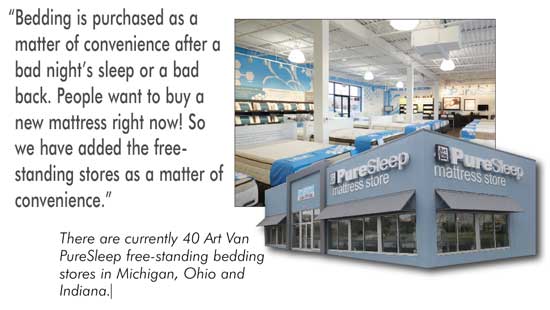
Growth, persistence and hard work were in the air and young Art caught all the passing breezes. He began life running. As a kid, Art sold newspapers on the streets of Detroit. Then one day his father took him to a haberdashery called Square Menswear, owned by Sarah and Abe Selikson. Asked Dad, “Do you have a job for my son?” The answer was “No”, but Dad persisted and the Seliksons eventually hired the teenager.
It was about this time that Art changed his name. As a salesman he “wanted something more catchy and memorable” than Archie. And his surname was too long. So, to his world, he became Art Van.
One of the Selikson’s relatives, Aubrey Shapiro, another haberdasher, later hired the then 16 year old to sell suits and overcoats. Art’s eldest daughter, Debbie, said, “It’s a reminder of how closely fashion, style, clothing and furniture are related. The Seliksons and the Shapiros taught him every aspect of the haberdashers’ trade to the refinements of men’s shirt cuffs and fabrics,” she said, “My father has always had an eye for style”. And, said Art, “With that background it was easy to transfer into the furniture business”.
The road leading to Art’s encounter with the Beatles and beyond is lovingly detailed in the company’s 136-page history in illuminating and entertaining chronologic order. He began his climb in 1951 when he joined Crown Furniture. By 1953, he had jumped the ranks to store manager. In 1954, Art left Crown and, with his partner, Jack Medvin, opened Shorewood Furniture as St. Clair Shores. But his former boss at Crown called him back. He returned as operations manager of three of Crown’s stores.

Success, yes. But with his Dad’s words ringing in his receptive ears, Art still wanted his own business, to be “in charge of his own future”. The first Art Van store, 4000 square feet, was located at Gratiot Avenue and 10 Mile Road. To finance it, Art, then a father of five, age 29, mortgaged his home. Unbelievably, he added two stores that same year in Warren and Detroit. In 1960, another store came aboard and, a landmark, Art hired his first employee, Al Hassan. You could logically ask, his first employee? How in the world could he have managed alone? Son Gary, Art’s eldest child, explains. “There was a house set-up beyond the store showroom, and my Dad ultimately made that area a part of the store’s showroom.” Gary was seven years old when Art opened shop. “My Dad started by himself. When I say himself, I mean himself. If he had to go to the bathroom, he took the cashbox with him. He also made all the deliveries.”
Art reflects now, “I was very determined. I got married when I was 19 years old and we had one kid after another.” Today, he has 10 children. “If you don’t think that motivates you, nothing will! I figured I’d better get out and move it.”
In order to comprehend the family’s dedication it’s important to expand our overview of their home as well as their business lives, intermingled as they were. Gary and Debbie both got their first paychecks at an early age for sweeping and dusting as did Ken, at age 10, Art’s training philosophy involved providing his children with a variety of simple responsibilities. Ken did officially join the company later; he retired in 2008. Debbie was Art’s administrative assistant until her retirement in 2005. Other family members have been part of Art Van’s over the years, grandchildren and others. A family affair.
Said Gary, “I’ve learned from Dad that the family members who chose to work here are here because they are responsible and want to be here. It’s a privilege and not something that’s just given to you. That’s important to me.”
It wasn’t all work, the kids had fun, too. After store hours and on Sundays, chores were accomplished around the house rewarded by trips to the local drive-in theatre and, in the summertime, the family rented a cottage at Caseville, Michigan. And the troop spent many hours driving around with Dad before or after the theatre looking for new store locations.
In 1961, another store was acquired, this one in Farmington. Clint Loren, employee number two came on board. A year later, Art Van Furniture acquired its first warehouse on Groesbeck Avenue in Warren. By 1963, seven stores bore Art’s name. And then, of course, as we’ve seen, 1964 presented its own unique challenges!
After the fabled Beatles Bash, Art sold three of the stores to his partners and kept four. He bought out his partners eventually, and again became sole owner. The company grew steadily, and by the early 1970s, 15 Art Van stores graced the Detroit region. He was opening locations as competitors in the midmarket segment were closing, either downsizing or going out of business completely. Said Art, “From 1964 to 1970, I was pretty solid. I had made it pretty well. My key was to never extend anything – I either paid for it or had the I’s dotted and the t’s crossed so there was no chance of losing.”
There’s no doubt that Art’s father was his primary mentor. But as Art matured in the business world he discovered Peter Drucker, the management consultant, educator and author who invented the concept of management by objectives. Drucker drew attention to the emerging “information society” and the necessity for lifelong learning that featured the study of behavior and relationships. One of Art’s distillations of Drucker’s wisdom: “Take care of the customer and everything else will fall into place.”
As the years went by, Art absorbed more of Drucker’s wisdom. “His (Drucker’s) position was that most successful people continue to do the things that brought them their success. If they continue to do that, they are doomed to failure. The reason for that is that things continue to change and that you must change. I believed that. I understood it. I really took it to heart.
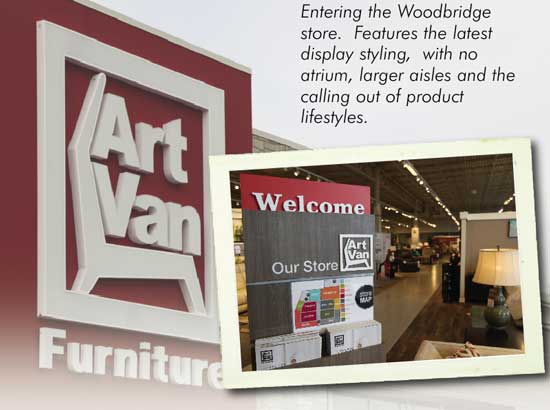
“But it’s easier said than done. The words are very simple. Doing it is something entirely different. You have to make sure you have people who are aware of what’s going on particularly in the style and fashion business that we’re in. You have to be aware of what’s going on in marketing. You have to continue to update your stores on a regular basis.”
The chronology ride jumps off again at the 1970 acquisition of the Tech Plaza store. In 1971, Royal Oak, Drayton Plains, Dearborn Michigan Avenue and Schoenherr turned on their lights. In 1973, Art moved the Tech Plaza store, corporate headquarters and the warehouse to the present 14 Mile Road location. 1974, ’75 and ’76 saw warehouse additions, the development of a training department and, year 1977, the opening of the Flint and Lansing stores. ’78, ’79 and ’80 introduced the Art Van credit card, the active design department and the arrival of the Livonia store. The next five years continued the race, efficiently opening and closing stores, adding to the warehouse facility and centralizing the service department.
1985 also marked the advent of the first Clearance Centre. These Centers sold damaged or overstocked merchandise at 40 to 70 per cent off retail, allowing the company to increase its market penetration. Art’s son, David Van Elslander, buyer for the Centers, said, “Art’s thought was to draw clearance centre shoppers into the store. Whether or not they bought at the first visit, they were intrigued by the ‘clearance’ lure. We cast a wider web. Today, the Centers represent the starting price point for us. In fact, 75 per cent of the business that is done is brand-new merchandise, something I’m not sure many people are aware of. The remainder of the sales are comprised of slightly damaged merchandise, special order returns, special purchases and one-of-a-kind items.”
The following year the video communication department came into being. No pause for breath! They soared into the ‘90s with massive additions to the warehouse, 13 more stores, more clearance centers, pioneered the mattress express service and the same-day service programmes, and somehow found time to rescue the great Thanksgiving Day Parade! (More about that later.)
Art Van’s massive warehouse is “probably the largest furniture warehouse in the nation”, said Manager John Schachermeyer. “You never know where we might ship to, Florida, Texas, Hawaii, Alaska, Canada or Beirut! We have a huge inventory and stock for immediate delivery. Of course, customers want it yesterday.”

Said Art, “Our warehouse covers a million square feet today and that allows us to stock about 98 per cent of the furniture found in our showrooms.” There is a European-inspired robotic retrieve and replenish system, and “a fleet of delivery trucks that treks more than five million miles per year through Michigan and Canada”.
The warehouse is as green as can be. And so is delivery with the company’s award-winning interest in alternative fuels for those trucks. Automation reduced the warehouse’s footprint and utility usage with very little lighting, heating and cooling needed, 75 per cent less when compared with a traditional warehouse. And, working with a variety of charitable organizations, Art Van recycles furniture and mattresses, participates enthusiastically in Arbor Day tree-planting programmes, and recycles tons of cardboard, plastic, metal, office waste and wooden pallets.
Leading up to the Millennium, more stores and more clearance centers opened, lots of remodeling, computer systems were installed, public relations/communications joined the fray, and next-day delivery was initiated. In 2006, commercial credit was offered to “guests”, and lifestyle presentations in the showrooms were staged. Feel a bit tired? Not Art. Diane Charles, Van Elslander’s communications expert, said “Mr. Van told the staff that the only thing that would remain the same at Art Van is the name on the building. You can choose to go backward or forward and we choose to go forward.”
He and his colleagues are constantly on the lookout for talent. Recruiting methods are as varied as the candidates they recruit. “We utilize traditional recruiting methods, advertising in newspapers, on line and on the radio and occasionally television. We are also very active in the ‘new media’, advertising on social websites such as Linked-In, Twitter and Facebook. But we still find that the best candidates come from word of mouth and associate referrals. Our associates know what kind of talent works best and they want to attract and retain other talented associates on our team.
“We are very proud of our training program. We honestly believe it is the best in our industry. We know for a fact that many of our direct and indirect competitors would love to get their hands on our training materials because some have even asked to buy them from us. We offer a wide variety of training, ranging from instructor classes and workshops, self-paced materials and even video-supported training. Our next step is to deliver our training to associates right on their mobile devices, which we’ll do this year.
“In order to attract and retain associates in any position you need to offer competitive salaries and benefits. Art Van associates receive commissions and can earn a six-figure income if they are good at what they do. Many of our management positions receive performance bonuses based on our company’s performance, and every associate ‘from stockroom to boardroom’ receives an annual profit sharing award based on company performance. This latter benefit is one we have been proud to provide for over 30 years. In addition, we have always maintained one of the best packages of health and other insurance benefits, no small achievement during these difficult times.
“We currently employ between 3500 and 4000 in our ‘family of associates’. Over the past few years we have grown very rapidly, adding almost a 1000 additional associates in the last three years. We could not have successfully grown as rapidly if it were not for our care of long-term associates. Almost 30 per cent of our associates have been with us 10 years or more, a remarkable number in an industry where the average tenure is often measured in months, not years. We are especially proud of the fact that almost 150 of our associates have been with us 30 years or more, a veritable lifetime of dedicated service. These associates are family!”
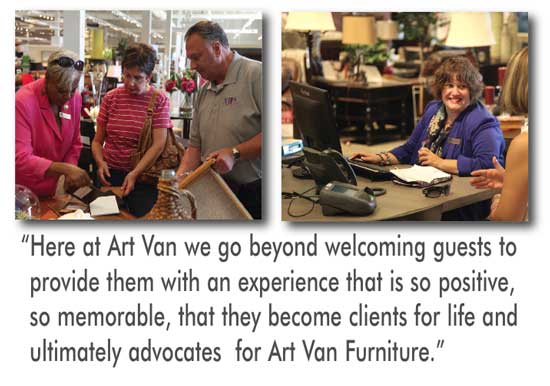
Many Art Van sales associates are certified interior designers while others not in possession of design certification have “a dedicated and loyal clientele who look to them for design and style information. However, our Scott Shuptrine division employs only certified designers”.
Independent designers are encouraged to bring their clients to the stores. “We know that many private clients of designers are looking for ‘affordable luxury’ and designers want to help their clients find ways to stretch their furniture dollars.”
Design has always been a strong factor in Art Van’s success story, “timeless elegance” with a top spin of au courant excitement. The Van Elslander’s “eye for style” was showcased when Scott Shuptrine Interiors opened in Royal Oak, the $3 million, 13,000 square foot flagship store, a product of more than a year and a half of planning. And there are two 5,500 square foot galleries within full-line showrooms at Art Van’s Warren, Grand Rapids and Petoskey stores. It’s actually a re-introduction for Shuptrine; it was originally acquired in 1986 but closed in 2002 because of the company’s need to focus on core business. Now the spectacular new studio will lead the company into luxury territory.
A website has been launched with a social media campaign that ties back into store happenings where photographs are taken, so “people get a chance to see themselves with their friends participating in social activities.” Kim Yost, CEO, said, “It’s a kind of Facebook, Twitter meets dotcom kind of thing. We created the space to be very social. There are amenities to entertain and serve guests, a piano at the foot of the staircase, a dining area and bar and a board room for group meetings or huddles between consumers and designers.”
The flagship store is uniquely structured, cleverly carved from a former parking space underneath the full-line store with its own special entrance as well as a dramatic interior entry into the 45,000 square foot Art Van showroom above. Exploring the new studio is an adventure; it features 60 outstanding room vignettes and about a third of the settings will change on a seasonal basis. Suppliers include Bernhardt, Drexel Heritage, Huntington House, Theodore Alexander, Curate, Elite Leather, Massoud, Natuzzi Italia, French Heritage, Maitland-Smith and Nathan Anthony.
“Upholstery receives special emphasis,” said Yost. “We want to own the living room. Our goal is for every luxury resident to have upholstered seating, whether stationary or motion, bought from Scott Shuptrine, because it is the statement of the home.” He added that the eclectic presentations are one of the ways Art Van is separating itself from competition. The connection with the strengths of Art Van lowers its operating costs and opens up more goods and services to the consumer. “All the back end is now shared with Art Van. Distribution, logistics, supply chain, the HR, payroll accounts payable and receivable. We’re benefitting from all the synergies of the back end.”
Promotionally, they have partnered with two local luxury magazines, The Hour and Ambassador. Store events will be hosted in conjunction with the publications and their mailing lists.
And Scott Shuptrine has become involved with area luxury realtors as well as independent designers for the store to become “their residence for events” and the go-to place for products, services and fulfillment.
There’s an expectation when the “build-out” is completed to do approximately $20 million in annual sales.
Kim Yost came to Art Van from The Brick, where he also served as CEO. Based in Edmonton, Alberta, The Brick is the parent company of a large Canadian chain. Both “Mr. Van” and Kim Yost have “leadership teams”, and they’ve formed a brains trust. Said Art, “The operation of the brains trust is simple. The rules of the game are we don’t have any rules. Whatever ideas the trust comes up with, if a majority says ‘no’, we don’t go for it. But we’ve been doing some things that are really unusual.”
He talked of a promotional pajama party for customers. “We used Twitter and Facebook, and two women at the ABC television station in Grand Rapids as connections. It was held on a Sunday night in the super-cold of winter. We had 450 people sign up and 900 came! It was unheard of, different, never been done before and it’s the kind of thing that gives you exposure. The women loved it. We’re trying different things, it works.” Peter Drucker would have loved it, too.
Art Van marketers are very well aware of the current growth of Detroit’s population, a resurgence. Particularly interesting is the young professionals demographic, “the Millennials”. Plans are afoot for special promotions targeted to this energy-packed group. At the last High Point Market, in fact, an event that fit the bill admirably in its potential for outreach was staged. The Art Van Furniture’s 2014 Spring Style Catalogue had been created in collaboration with Nigel Barker, internationally renowned photographer, author, filmmaker, celebrity judge in reality television and host of The Face of Oxygen. Art’s 144-page Catalogue shows “the flair and function of the season’s stylish collections through Baker’s high fashion lens”. The event to preview the catalogue was hosted by Art Van at the Bernhardt Showroom, a private “Art of Style” luncheon attended by both Alex Bernhardt Senior and Junior, Art and Nigel Barker, media and key industry leaders.
This gorgeously conceived and printed catalogue themed to “capture what women want this spring, effortless style that reflects their unique lifestyles and creative spirits”, was then presented to consumers at two special parties back on home turf and at the Chicago store. Guests enjoyed refreshments and music, and one of the highlights of the events was a “Supermodel Search” runway competition in which one grand prize winner at each store was selected by a panel of celebrity judges, including “Mr. Van” and Barker. The winners were featured in an Art Van Furniture advertisement, and received a $1000 Art Van gift card as well as a framed, autographed photo with Barker as a momento of the fete.
The Catalogue was made available “as long as they lasted” at all Art Van locations in Michigan, Illinois, Indiana and Ohio. Another “really unusual promotion”!
Preferred methods of reaching consumers nowadays obviously involve gorgeous catalogues as well as television, radio, print, Internet, social media and direct mail. “Mr. Van believes there is more than one way to sell a sofa.
We are always creating new ways to get folks into our stores whether it’s a ladies night out, Disney stars, catalogue parties or charity fundraisers.”
Advertising was key to overcoming Beatlemania as round-the-clock radio proved. Television ads now are featured at strategic times of the day. “Newspapers carry a preprinted circular from Art Van regularly, and special announcements appear on other days of the week in newspapers.” Every week TV and radio promote showrooms, bedding and the clearance centers. In the highly competitive 1970s, Art “kept up with the advertising.” He was one of the first furniture retailers to use TV in the Detroit area. In the ‘90s, he leaned heavily on print with full-page full-color ads in the papers three or four times a week.
President Gary, “Always listens to or reads the ads, see where they are positioned, what time they come on, what precedes them. “
Celebrity ads have been and are used. “People tend to tie the personality with the company. If they like the personality, they will like the company.”
On-line sales were initiated in 2000, just in time for the new century. The incorporation of Paul’s TV on-line as well as in-store combined with room packages is “one more way to find everything for your home at Art Van”.
Customer service to be proud of has always been key. “Every sales associate has access to an on-line customer contact system we call their ‘workbench’. This system provides them with a repository for customer information, lead and contact data and follow-up. The system will ‘cue’ the associate to make follow-up calls and contacts. Every associate writes a note thanking customers for their purchase and asking for referrals.
“There is a dedicated customer call centre, highly trained to help customers with any issues they might encounter with their purchases. After all, Art Van is all about creating a long-lasting relationship with our customers. The Central System was set up in1985 with five associates. Now it has 230 associates. In total there are four departments that include the Call Centre, in-home service, the repair centre and quality control.
“We want our customers or ‘guests’ to feel as welcome as if they were in the home of a trusted friend. Here at Art Van we go beyond welcoming guests to provide them with an experience that is so positive, so memorable, that they become ‘clients for life’ and ultimately ‘advocates’ for Art Van Furniture. This is what makes us different.”
Years ago, Art Van research revealed that “two income families with busy parents did not have the time to shop nor the desire to spend time away from their children. In 1998 an expansion of the flagship store in Warren was unveiled with the introduction of the first Kid’s Castle. The tyke-friendly paradise within the store is comprised of 1400 square feet of play space that features climbing structures, a TV room and a ball-play area. Art Van staffers supervise children while their parents shop. Other Kid’s Castles were developed and now there are more than a dozen. As the company redesigns its stores the programme will evolve, and Art Van will provide additional fun spaces for kids.”
Delivery at Art Van also has a special panache. “We call it our ‘Legendary Delivery’. That includes a friendly and personal greeting, a team that is considerate of the homeowner’s home and property, making sure our furnishings are delivered in a ‘ready to use’ state, and treating every guest as if they were their own family member.”
Van Elslander has invested heavily in his various communities. “Very simply, I believe that if you are lucky enough to be as successful as we are, I think it’s a responsibility to give back to your community, and I think we try to give back in a sincere, honorable way.” That Thanksgiving Day Parade? The beloved, nationally televised Detroit event began in 1924 but, by 1990, it was in trouble and in danger of being canceled. Susie Gross, former President of the Parade Company, a non-profit organization, said, “The lights were about to be turned out on a tradition, and Art Van rescued it by rallying financial support.”
Debbie said, “They called Dad in the last hour for help. He brought it back to life operationally. That inspired other businesses to get on board.” Art wrote a check for $200,000 that enabled the Parade to go on, and the following year he announced that he would match the contributions of other businesses up to $100,000. Art Van got into the action, too, by building its own float every year. Debbie remembers “our whole family walking beside the company float in 1990” as did the families of many Art Van employees. Themes ranged from “chomping crocodiles to friendly dragons, Alice in Wonderland and Peter Pan, Aesop’s Fables and Old King Cole. The special 50th anniversary float heralded “the Charitable Knights of the Round Table”!
Charitable events are a continuous activity. Other beneficiaries over the years have and do include St. Vincent de Paul, the National Cherry Festival, Toys for Tots, Focus Hope, Forgotten Harvest and many others. Stores are offered as venues for blood drives and flu shot clinics, health fairs and pet adoptions. “In the latter part of the 1990s, we started a family foundation,” said Debbie. “My parents have favorite places to donate, those facilities that have to do with children and hospitals certainly.” The Million Dollar Charity Challenge is one of Art’s concepts. Initiated in 2009 at the company’s 50th anniversary, 50 local nonprofit organizations dealing with children, health and human services were invited to apply for grants that range from $5,000 to $50,000 that, in turn, must be matched by other donors. “We have people from all over the State writing to us and there’s a Board that selects which are to get the money.”
Mr. Van’s activities have not gone unrecognized. The National Home Furnishings Association named Art Van Furniture the Retailer of the Year in 1998. He was awarded Humanitarian of the Year kudos by the American Jewish Committee. He was Goodfellow of the Year, and was also the Greater
Detroit Outstanding Philanthropist. Environmentally, in acknowledgment of their green efforts, the Michigan Retailers Association made Art Van Furniture the 2007 Green Tailer. Art and his family have been recognized by Angel’s Place, the Michigan Cancer Foundation, the Catholic Youth Organization, the National Anti-Defamation League, and American Heritage. Art was inducted into the American Furniture Hall of Fame in 2001. And the Spirit of Life Award from City of Hope, and the Ernst and Young Lifetime Achievement Award lauded him.
The future, what does it hold for the company? “We see the future of AVF as healthy, continuing to expand throughout the Midwest from our Distribution Centre in Warren which will be well over a billion dollars. The big will continue to get bigger. It will be almost impossible for the smaller merchant to exist. It will require more areas of specialization that the small guy just can’t keep up with, buying, advertising, freight and selection.
“Also, our targeted Millennials are growing at a rapid speed and they will provide another big boost for the business. And financial people are becoming more and more interested in the furniture industry.
“I have been blessed with some very good people. I don’t think there’s any one person who can take credit for building the size organization we have. I could say I was lucky enough, maybe wise enough, I’m not sure which, to surround myself with a good team.
”I’m always amazed when I hear someone say ‘I’ve paid my dues, I’ve arrived, I’m done!’ I think that’s like telling me yesterday’s box scores. Frankly, I’d rather talk about the upcoming game and what we need to do to win!
“One thing is certain. We will all need a place to gather for dinner, sit in front of a cozy fire, read to our grandchildren, and get a good night’s sleep. We look forward to remaining an active supporter of our local communities and, as always, we will go where our customers lead us.”
Janet Holt-Johnstone is retail editor at Furniture World Magazine.